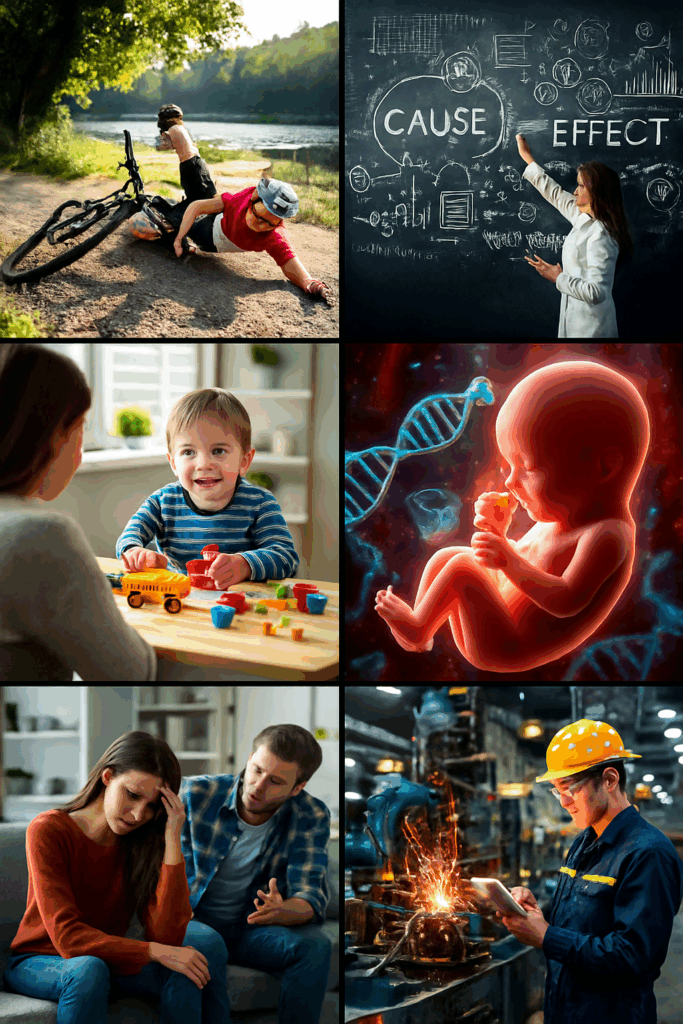The Law of Cause and Effect: Scientific Perspectives on Determinism, Complexity, and Human Outcomes

Abstract
The “Law of Cause and Effect” asserts that every phenomenon arises from antecedent conditions and in turn influences subsequent events. While historically treated as a metaphysical principle, modern science has developed rigorous frameworks for analyzing causality across disciplines. This article reviews contemporary approaches to causal inference, examines the role of determinism and complexity in natural systems, discusses accident causation and prevention, and explores the multifactorial origins of congenital anomalies. The analysis demonstrates that while causal chains are real and scientifically tractable, they often operate probabilistically within nonlinear, multilevel systems. Understanding these dynamics has profound implications for public health, safety, and ethics.
1. Introduction
Causality lies at the core of scientific reasoning. To claim knowledge of a system is to identify how interventions produce changes in outcomes. The Law of Cause and Effect, formulated broadly, holds that no event occurs in isolation: every occurrence is both the result of prior circumstances and a contributor to future ones. Scientific inquiry operationalizes this principle through formal frameworks that allow causes to be distinguished from mere correlations.
2. Formal Frameworks of Causality
Two dominant frameworks provide the foundation for contemporary causal analysis:
- Structural Causal Models (SCMs). Developed by Judea Pearl, SCMs employ directed acyclic graphs to represent hypothesized causal structures and counterfactual reasoning to test interventions. This allows scientists to evaluate “what if” questions, such as whether an outcome would have occurred had an exposure been absent (Pearl, 2009).
- Potential Outcomes Framework. Also known as the Neyman–Rubin model, this framework defines causal effects as contrasts between potential states of the same unit under different exposures. It underlies the design of randomized controlled trials, which remain the gold standard for causal inference (Rubin, 1974; Hernán & Robins, 2020).
In epidemiology, Bradford Hill’s criteria offer practical guidelines for judging causality when experiments are not possible, emphasizing temporality, consistency, and plausibility (Bradford Hill, 1965).
3. Determinism, Probability, and Complexity
Scientific perspectives on causality integrate both deterministic and probabilistic dimensions:
- Deterministic laws. Classical physics demonstrates that given initial conditions, the trajectory of a system can in principle be predicted. This deterministic view underpins engineering and many natural sciences.
- Chaos and unpredictability. Even in deterministic systems, small differences in initial conditions can lead to divergent outcomes, as shown in Lorenz’s foundational work on chaotic weather systems (Lorenz, 1963). Determinism does not guarantee predictability.
- Complex systems and emergence. Biological and social systems exhibit emergent properties that cannot be reduced to single variables. Complexity science emphasizes multilevel interactions and feedback loops, where outcomes are influenced by nonlinear dynamics and probabilistic variation (Mitchell, 2009).
4. Accident Causation: From Individual Errors to Systemic Factors
In safety science, the Law of Cause and Effect manifests in models of accident causation.
- Heinrich’s Domino Theory (1931) conceptualized accidents as sequences of causes; removing one domino prevents the outcome.
- Reason’s Swiss Cheese Model (1990) highlighted how latent organizational failures and active human errors align to produce accidents.
These frameworks emphasize that what is often labeled “an accident” is in fact the predictable outcome of interacting factors. Prevention requires addressing systemic as well as individual contributors.
5. Congenital Anomalies: Multifactorial Causation
One of the most sensitive applications of causal reasoning concerns congenital malformations. Scientific consensus indicates that such conditions rarely result from a single cause. Instead, they arise through gene–environment interactions involving:
- Genetic mutations and chromosomal abnormalities.
- Maternal exposures to teratogens (e.g., alcohol, thalidomide, infections).
- Nutritional factors such as folate deficiency.
- Stochastic events during embryonic development (Sadler, 2012; Kalter, 2003).
Epidemiological studies show that preventive measures—such as rubella vaccination, folic acid supplementation, and avoidance of teratogens—reduce risks significantly (Christianson et al., 2006). The causal framework here is probabilistic: exposure increases likelihood but does not guarantee outcome.
6. Ethical and Philosophical Implications
The scientific Law of Cause and Effect should not be conflated with moral determinism. Recognizing that every outcome has causes does not imply blame but rather responsibility for prevention and mitigation. Public health exemplifies this: causal knowledge is used to design interventions that reduce harm across populations (WHO, 2016).
7. Conclusion
Scientific inquiry confirms the essence of the Law of Cause and Effect: every phenomenon is embedded within causal networks that extend across time and scale. However, causation is rarely linear; it is structured, probabilistic, and emergent. By integrating causal frameworks with complexity theory, modern science both affirms and nuances the ancient intuition that “nothing happens by chance.” This understanding empowers society to prevent harm, promote health, and appreciate the interconnectedness of all events.
References
- Bradford Hill, A. (1965). The environment and disease: association or causation? Proceedings of the Royal Society of Medicine, 58(5), 295–300.
- Christianson, A., Howson, C. P., & Modell, B. (2006). March of Dimes Global Report on Birth Defects. March of Dimes.
- Hernán, M. A., & Robins, J. M. (2020). Causal Inference: What If. Chapman & Hall/CRC.
- Kalter, H. (2003). Teratology in the 20th century: environmental causes of congenital malformations in humans and how they were established. Neurotoxicology and Teratology, 25(2), 131–282.
- Lorenz, E. N. (1963). Deterministic nonperiodic flow. Journal of the Atmospheric Sciences, 20(2), 130–141.
- Mitchell, M. (2009). Complexity: A Guided Tour. Oxford University Press.
- Pearl, J. (2009). Causality: Models, Reasoning, and Inference (2nd ed.). Cambridge University Press.
- Reason, J. (1990). Human Error. Cambridge University Press.
- Rubin, D. B. (1974). Estimating causal effects of treatments in randomized and nonrandomized studies. Journal of Educational Psychology, 66(5), 688–701.
- Sadler, T. W. (2012). Langman’s Medical Embryology (12th ed.). Lippincott Williams & Wilkins.
- World Health Organization. (2016). Congenital anomalies: Report of a WHO Expert Committee. WHO.
